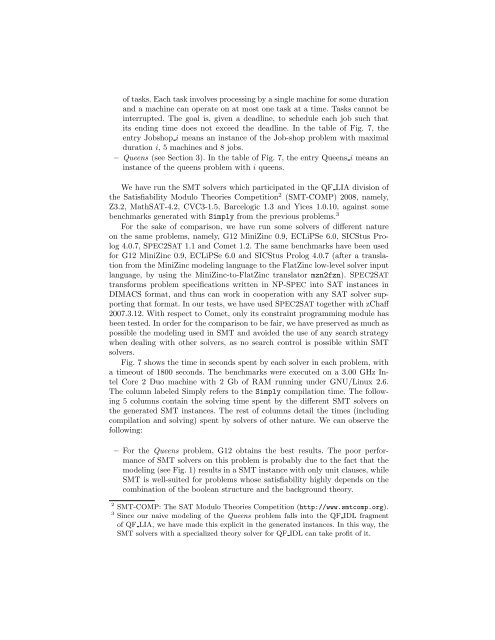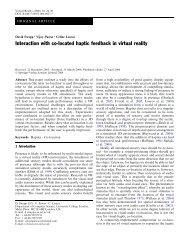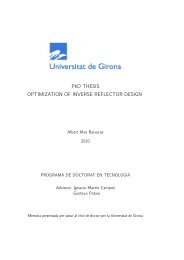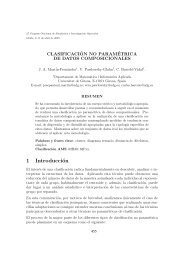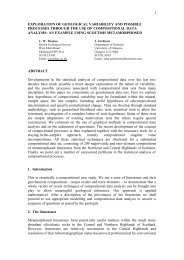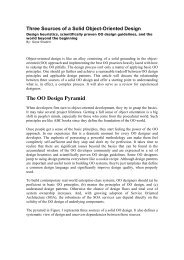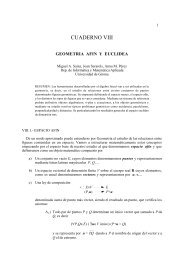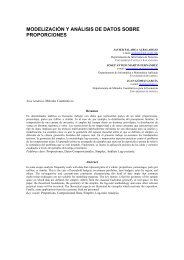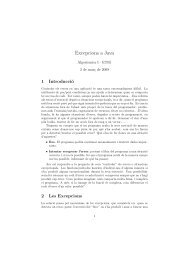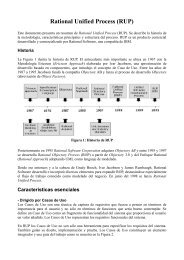SIMPLY: a Compiler from a CSP Modeling Language to the SMT-LIB ...
SIMPLY: a Compiler from a CSP Modeling Language to the SMT-LIB ...
SIMPLY: a Compiler from a CSP Modeling Language to the SMT-LIB ...
You also want an ePaper? Increase the reach of your titles
YUMPU automatically turns print PDFs into web optimized ePapers that Google loves.
of tasks. Each task involves processing by a single machine for some durationand a machine can operate on at most one task at a time. Tasks cannot beinterrupted. The goal is, given a deadline, <strong>to</strong> schedule each job such thatits ending time does not exceed <strong>the</strong> deadline. In <strong>the</strong> table of Fig. 7, <strong>the</strong>entry Jobshop i means an instance of <strong>the</strong> Job-shop problem with maximalduration i, 5 machines and 8 jobs.– Queens (see Section 3). In <strong>the</strong> table of Fig. 7, <strong>the</strong> entry Queens i means aninstance of <strong>the</strong> queens problem with i queens.We have run <strong>the</strong> <strong>SMT</strong> solvers which participated in <strong>the</strong> QF LIA division of<strong>the</strong> Satisfiability Modulo Theories Competition 2 (<strong>SMT</strong>-COMP) 2008, namely,Z3.2, MathSAT-4.2, CVC3-1.5, Barcelogic 1.3 and Yices 1.0.10, against somebenchmarks generated with Simply <strong>from</strong> <strong>the</strong> previous problems. 3For <strong>the</strong> sake of comparison, we have run some solvers of different natureon <strong>the</strong> same problems, namely, G12 MiniZinc 0.9, ECLiPSe 6.0, SICStus Prolog4.0.7, SPEC2SAT 1.1 and Comet 1.2. The same benchmarks have been usedfor G12 MiniZinc 0.9, ECLiPSe 6.0 and SICStus Prolog 4.0.7 (after a translation<strong>from</strong> <strong>the</strong> MiniZinc modeling language <strong>to</strong> <strong>the</strong> FlatZinc low-level solver inputlanguage, by using <strong>the</strong> MiniZinc-<strong>to</strong>-FlatZinc transla<strong>to</strong>r mzn2fzn). SPEC2SATtransforms problem specifications written in NP-SPEC in<strong>to</strong> SAT instances inDIMACS format, and thus can work in cooperation with any SAT solver supportingthat format. In our tests, we have used SPEC2SAT <strong>to</strong>ge<strong>the</strong>r with zChaff2007.3.12. With respect <strong>to</strong> Comet, only its constraint programming module hasbeen tested. In order for <strong>the</strong> comparison <strong>to</strong> be fair, we have preserved as much aspossible <strong>the</strong> modeling used in <strong>SMT</strong> and avoided <strong>the</strong> use of any search strategywhen dealing with o<strong>the</strong>r solvers, as no search control is possible within <strong>SMT</strong>solvers.Fig. 7 shows <strong>the</strong> time in seconds spent by each solver in each problem, witha timeout of 1800 seconds. The benchmarks were executed on a 3.00 GHz IntelCore 2 Duo machine with 2 Gb of RAM running under GNU/Linux 2.6.The column labeled Simply refers <strong>to</strong> <strong>the</strong> Simply compilation time. The following5 columns contain <strong>the</strong> solving time spent by <strong>the</strong> different <strong>SMT</strong> solvers on<strong>the</strong> generated <strong>SMT</strong> instances. The rest of columns detail <strong>the</strong> times (includingcompilation and solving) spent by solvers of o<strong>the</strong>r nature. We can observe <strong>the</strong>following:– For <strong>the</strong> Queens problem, G12 obtains <strong>the</strong> best results. The poor performanceof <strong>SMT</strong> solvers on this problem is probably due <strong>to</strong> <strong>the</strong> fact that <strong>the</strong>modeling (see Fig. 1) results in a <strong>SMT</strong> instance with only unit clauses, while<strong>SMT</strong> is well-suited for problems whose satisfiability highly depends on <strong>the</strong>combination of <strong>the</strong> boolean structure and <strong>the</strong> background <strong>the</strong>ory.2 <strong>SMT</strong>-COMP: The SAT Modulo Theories Competition (http://www.smtcomp.org).3 Since our naive modeling of <strong>the</strong> Queens problem falls in<strong>to</strong> <strong>the</strong> QF IDL fragmen<strong>to</strong>f QF LIA, we have made this explicit in <strong>the</strong> generated instances. In this way, <strong>the</strong><strong>SMT</strong> solvers with a specialized <strong>the</strong>ory solver for QF IDL can take profit of it.


